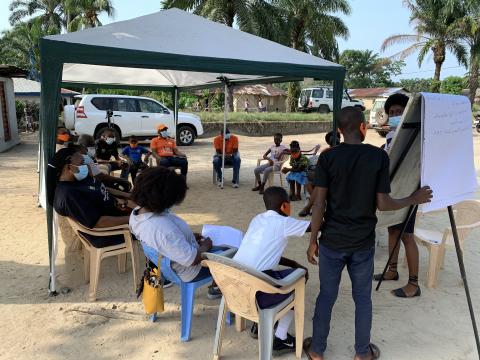Reviewing a national office strategy through the eyes of children

When the heat of the day goes down and the sky lights up beautifully on a late afternoon in Korigbondo southern Sierra Leone, it is time for kids club members, drawn from clubs across the district, to meet and interact with the Senior Leadership team of World Vision in Sierra Leone. With beaming smiles, the children rush to the vehicles with elbows flying, their face masks respecting the new normal that COVID-19 has created, to greet every member of the entourage of directors who have arrived to hear their stories.
Sagane Thiaw, World Vision’s Interim National Director, Operations Director Grace Kargbo, Finance Director Elvis Van-Dalen, People and Culture Director Sophia Loveday, and Resource Acquisition and Management (RAM) Director Yhen Veso all look as though flashes of their kindergarten years have returned. With good cheer, the children lead the leadership under a big tree where colourful chairs and a green canopy that perfectly matches the leaves of the surrounding trees are waiting for this team.
The senior leadership team from World Vision often engages with children at every level individually, but on this day it is part of their group retreat itinerary to meet with staff in the field and children, in particular, to engage them on their knowledge of the work of the organisation. They need to find out how much children actually know about the work of World Vision.
The answers from the kids and their understanding of child well-being and the Child Rights Act leave World Vision’s leadership team electrified with a new understanding from a child’s point of view which will inform the organisation’s strategy review. Among the questions they have for children, the leadership team seeks to find out: What World Vision programming work and actions are the girls and boys aware of in their community? What is World Vision doing to improve child well-being and rights? What could the organisation do better? What are the children doing to improve child well-being and rights, and community development?
Tenema, one of the children, brilliantly explains on behalf of her colleagues with the aid of a flip chart they have carefully designed together how World Vision is engaged in three strategic areas: Health, Education, and Child Protection. She notes that Water, Sanitation and Hygiene (WASH) is a cross-cutting theme and how World Vision has been building hygiene and water facilities in hospitals and schools within their various communities. She says World Vision has also boosted the livelihoods of their parents through the Savings for Transformation (S4T) approach. According to Tenema, World Vision has exposed them (children) to their rights and responsibilities as children, and they can now advocate on behalf of their colleagues. She adds that because of their advocacy work, children are considered champions in their communities, and their lives influence other children's.
At the end of what the directors consider to be a life-changing experience, the children proffer several recommendations for effective programming and improvement on their advocacy work. They implore the leadership to create an avenue for them to meet with the President of the Republic of Sierra Leone to present a position paper on how the state can better support children. They also beseech the organisation's leaders to expand operations to other communities where other vulnerable children can be found and entreat them to extend WASH facilities to communities that are in great need of water and sanitation. They consider their skills of reaching out to their peers as immeasurable and therefore request support to host more radio talk shows that cater to children.
In response, Sagane Thiaw thanks the children for their brilliance and informs them that their thoughts have been captured and will be incorporated into World Vision's national office strategy review for Sierra Leone. He enlightens them that the principles of the United Nations Convention on the Rights of the Child affirm the right of children to have a voice in all matters affecting them, including in public decision-making. He assures the children of how pleased the leadership team is to be hosted by children, and admonishes them to continue in the path the kids club has paved for them, putting education and God at the centre. A prayer for a successful leadership retreat and for the kids to attain their goals and dreams in the future climaxes the friendly interaction.
World Vision fights for children every single day with a vision for every child to enjoy life in all its fullness, and a prayer for every heart the will to make it so. The leadership and staff of World Vision believe that every child should be able to make their mark on the world and live a life free of fear and live to see opportunities for growth and well-being. Therefore, the organisation stands side by side with children in the toughest places to be a child, doing whatever it takes to make sure they survive, get protection when they’re in danger, and have the chance to grow.